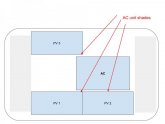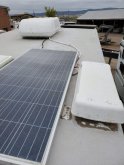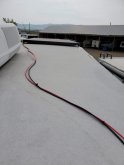sunrise
New Member
- Joined
- Jul 16, 2020
- Messages
- 206
Hi,
I am about to install 2-3 Renogy 100W compact panels on roof top of my 16' travel trailer, due to space constraint, panels will be installed by sides of the AC unit.
As you can see the top row of PV2 cells could be entirely in AC's shadow if sun shines from the other side of the AC unit. This is not ideal and I accept this . But for Pv1 and Pv3, they both have only a small corner (1-2 cells out of 33) that could be in shadow of AC unit, I have read different stories on how much a single cell could drag down output to a fraction of its max.
Could some one give some idea on how much of PV1/3's output would be reduced? If it's more than half, then maybe it's better to do a 50w panels instead to so the panel is completely off the shadow of the AC unit?
Note that the grey area in diagram is not suitable to mount panels, no room to maneuver there due to fan, vent, antenna, etc.
Thanks!

I am about to install 2-3 Renogy 100W compact panels on roof top of my 16' travel trailer, due to space constraint, panels will be installed by sides of the AC unit.
As you can see the top row of PV2 cells could be entirely in AC's shadow if sun shines from the other side of the AC unit. This is not ideal and I accept this . But for Pv1 and Pv3, they both have only a small corner (1-2 cells out of 33) that could be in shadow of AC unit, I have read different stories on how much a single cell could drag down output to a fraction of its max.
Could some one give some idea on how much of PV1/3's output would be reduced? If it's more than half, then maybe it's better to do a 50w panels instead to so the panel is completely off the shadow of the AC unit?
Note that the grey area in diagram is not suitable to mount panels, no room to maneuver there due to fan, vent, antenna, etc.
Thanks!






